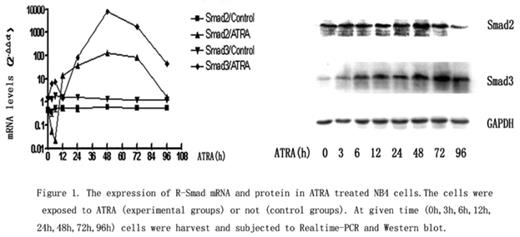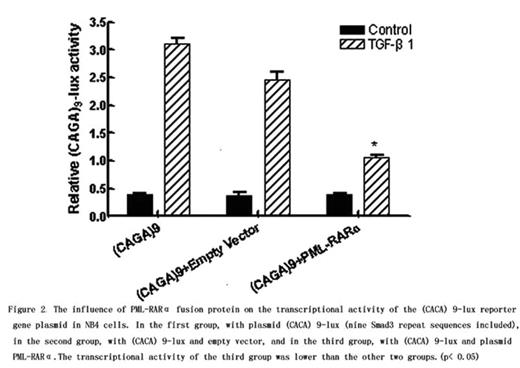Abstract
It was reported that several members of TGF-β1 signaling pathway had the situation of reduced expression, absence or abnormal function in mononuclear cell of acute leukemia patients. Our preliminary experiments also found that the expression of TGF-β1 receptors and several downstream Smad proteins decreased considerably than those after induced differentiation in a APL cell line (NB4) and primarily cells of APL patients. In order to further investigate the important links in TGF-β1 pathway in induced differentiation of APL cells by ATRA, R-Smad, namely the change of Smad2 and Smad3 protein expression, we detected mRNA and the protein expression of Smad2,Smad3 by Realtime-PCR and Western blot after we brought ATRA to act on cell NB4 and primary cells of patient for 0, 3, 6, 12, 24, 48, 72 and 96 hours. Cells treated with dehydrated alcohol were harvested at the given time as control group. As to NB4, The expression of Smad2 and Smad3 mRNA tested showed a significant increase treated with ATRA measured by PCR. In contrast, the expression levels in the control groups remained almost unchanged with time(p<0.01). After ATRA induced, Smad2 and Smad3 levels emerged a gradual rising trend, reached maximum value up to 48h (126.11±1.06,7780.09±288.58)and then gradually declined. Western blots showed that the degree of Smad2 protein was increased at 3h, which peaked at 48h, before returning to baseline level at 72h. Simultaneously, elevation of Smad3 was observed. The expression level was increased within 6h, up to the peak at 72h which was later than Smad2, and then dropped down. In the aspect of the primary cells, Western results showed that three De novo patients had extremely low Smad2 and Smad3 protein expression, but after activated by ATRA for 48h, their levels were increased significantly. These experiment results showed that a R-Smad reduction or absence might exist in APL, and that APL cells differentiation might something to do with up-regulating of expression of R-Smad. Its concrete mechanism might be associated with PML-RARα fusion protein. We analyzed the influence of PML-RARα on the transcriptional activity of the (CACA) 9-lux reporter gene plasmid(including nine tandem repeated CAGA sequence that may combine Smad3 and Smad4) and found that PML-RARα may inhibit the transcription regulation of R-Smad. In IF experiment, we observed that there was a phenomenon that PML-RARa protein in NB4 cells combined with Smad2, Smad3 protein respectively. The phenomenon presented an obvious falling tendency after activated by ATRA for 24, 48 and 72 hours. HK Lin et al. found that cytoplasmic PML (cPML) in normal cells could mediate the formation of complex TGF-β1 receptor/R-Smad/SARA, and thus activate TGF-β1 signaling pathway. We guess that PML-RARa may combine with the R-Smad, therefore, block the transcription control for genes of TGF-β1 pathway.
The expression of R-Smad mRNA and protein in ATRA treated NB4 cells. The cells were exposed to ATRA (experimental groups) or not (control groups). At given time (0h, 3h, 6h, 12h, 24h, 48h, 72h, 96h) cells were harvest and subjected to Realtime-PCR and western blot
The expression of R-Smad mRNA and protein in ATRA treated NB4 cells. The cells were exposed to ATRA (experimental groups) or not (control groups). At given time (0h, 3h, 6h, 12h, 24h, 48h, 72h, 96h) cells were harvest and subjected to Realtime-PCR and western blot
The influence of PML-RARα fusion protien on the transcriptional activity of the (CACA) 9-lux reporter gene plasmid in NB4 cells. In the first group, with plasmid (CACA) 9-lux (nine Smad3 repeat sequences included). In the second group, with (CACA) 9-lux and empty vector, and in the third group, with (CACA) 9-lux and plasmid PML-RARα. The transcriptional activity of the third group was lower than the other two groups. (p<0.05)
The influence of PML-RARα fusion protien on the transcriptional activity of the (CACA) 9-lux reporter gene plasmid in NB4 cells. In the first group, with plasmid (CACA) 9-lux (nine Smad3 repeat sequences included). In the second group, with (CACA) 9-lux and empty vector, and in the third group, with (CACA) 9-lux and plasmid PML-RARα. The transcriptional activity of the third group was lower than the other two groups. (p<0.05)
Author notes
Disclosure: No relevant conflicts of interest to declare.



This feature is available to Subscribers Only
Sign In or Create an Account Close Modal